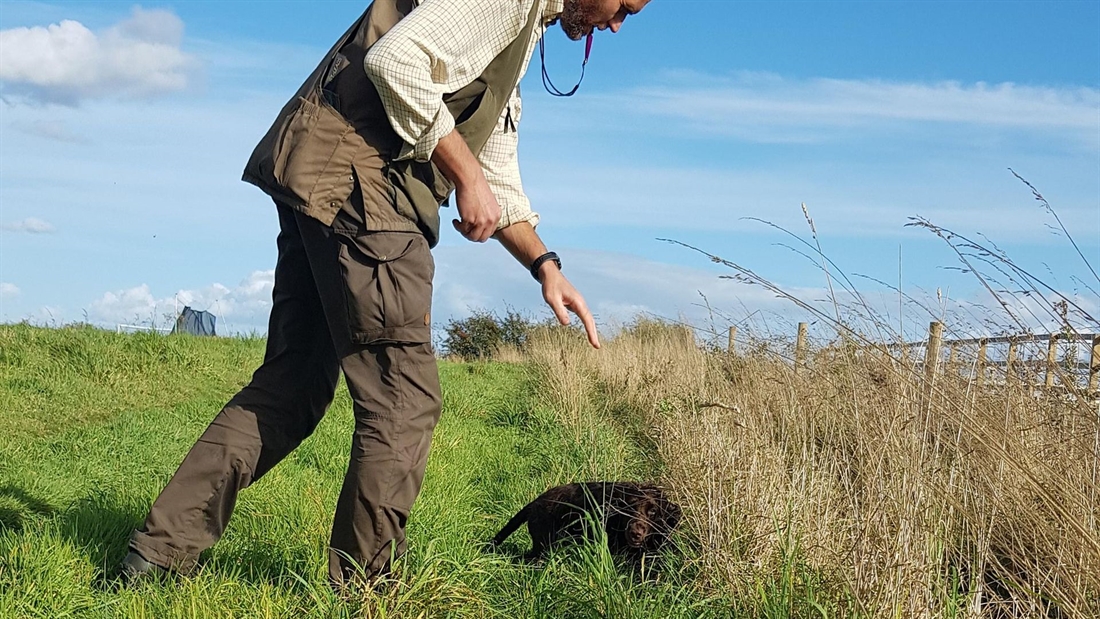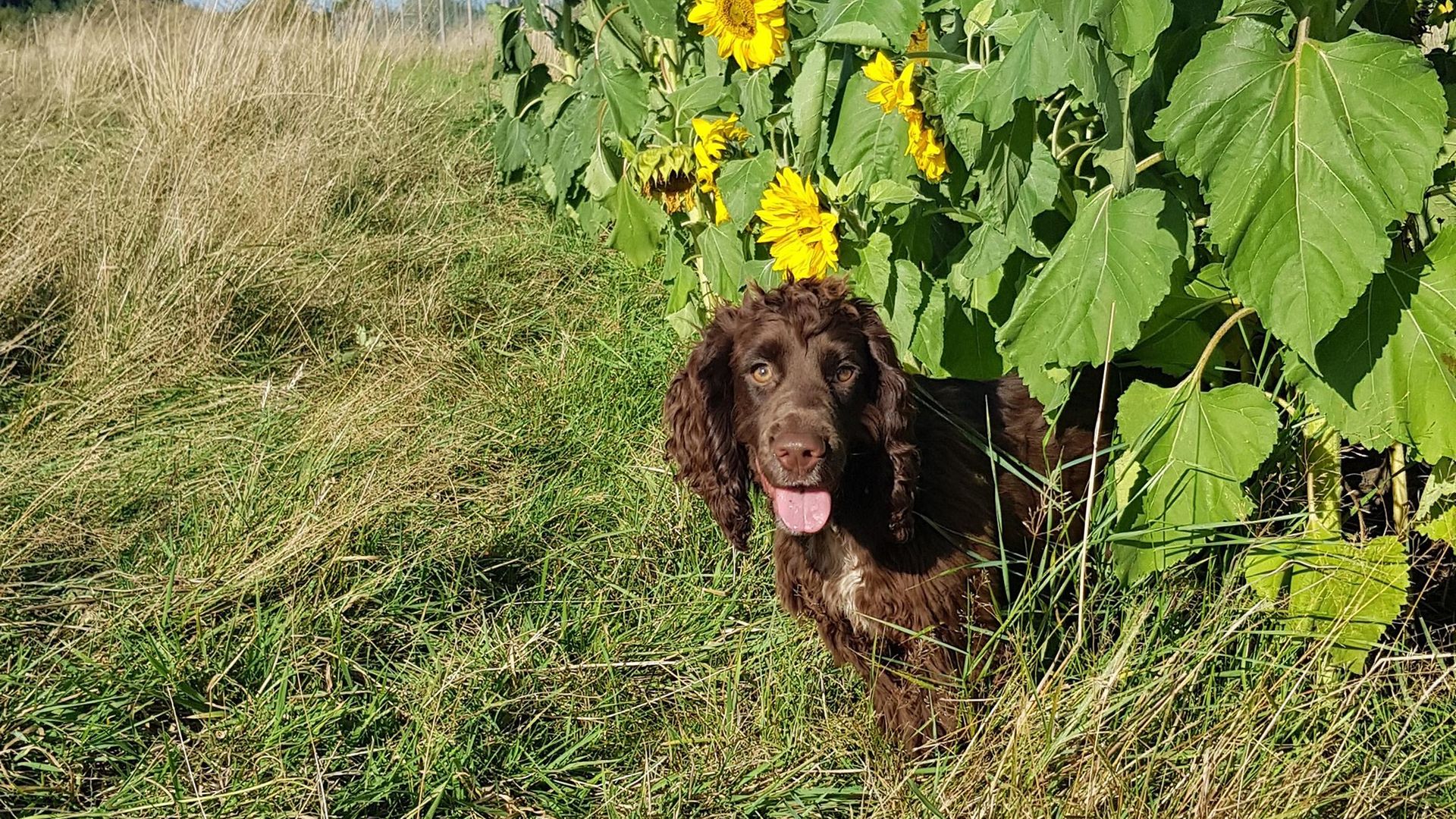How to: introduce cover to young gundogs

Ryan Kay looks at gundog training timescales, and explains how to introduce cover to dogs of any age, no matter what stage of their training they are at…
One thing I often get asked about is timescales: i.e. when should a dog be performing a certain task or showing a particular aptitude or skill towards something? Some new handlers can be very worried about what they think their dog should be carrying out by a certain age. That’s all fine, because if I have a client like that, it shows me that they are keen to progress. Their concern is also completely understandable because there’s always someone willing to post a picture or video on social media of a puppy undertaking a task at four months old that you’d perhaps expect a two-year-old adult dog to be doing.
The customer has watched the video and thought: ‘Oh no, I’m so far behind with my training. What am I doing wrong?’ Well, I’ve said it before, there are no timescales, only thoughtful decisions about what you reveal to your dog at any given time, especially when it comes to game and the exciting environment of the shooting field. It’s essentially all dependent on the dog itself, your experience as a handler and what resources are available to you.
We currently have three cocker pups of different ages at Farlavale: Merlin, at three months, Jimmy, five months, and Biscuit, eight months. Jimmy and Biscuit were bred by us, while Merlin came from a breeder in Wales
from lines we know and trust. All three are completely different in every way. Different shapes, colours, personalities, nature, natural ability, cleverness, energy levels and biddability! My job is to adjust and respond accordingly to each individual disposition.
They did, however, all start their training life the same way – that’s to say, they were all given the same encouragement and the same approach. What happens after that are simple adjustments on my behalf as I respond differently to what behaviours the dogs are playing out in front me. Of course, it can be tricky to know how to respond or what to teach your dog at any given age, especially if you’re a first-timer.
What stage should my dog’s training be at at his age?
There are no hard and fast rules, and the best advice I can give you is to try and be reactive when putting methods into practice. Rather than carry out the method regardless of how the dog is responding, change what you’re doing instantly to get the desired behaviour. If you’re getting suitable results, great! If not, change your method or adjust the current one.
Of our three different pups, it is in fact little Jimmy the five-month-old that’s perhaps the furthest ahead in his training. He shows the greatest aptitude and maturity, being a very quick learner, with excellent concentration levels. This intelligence can present other problems, though; because as he’s such a fast learner, I’ll need to be aware of what he’s learning when he’s not interacting with me – for example, when he’s perhaps with other members of the family. The reason I need to be so aware is that he’s still in, and will remain in, the most crucial learning period of his life for the next eight months or so, so I need to carefully manage all of his exposure, which is subsequently his learning.
What age should I introduce my gundog to cover?
The main consideration then for many of us is when to expose a dog to different exciting aspects. Aside from the usual puppy training of basics, manners, routine, and perhaps initial retrieves etc, what else can you safely teach your pup without ruining it, so to speak? There is one area I like to introduce to any dog at any age, and that is cover! And when should you introduce cover? Well, how about right now?! All three of our pups were given early introductions to cover, and all are given regular exposure and training in cover, even little Merlin at just three months.
You can introduce cover to any breed of dog from the word go. In fact, I find that it’s really valuable for some retriever breeds to start with cover as early as possible. The important thing is to make it inviting. Just slightly longer grass to start with is fine, perhaps throwing a treat in there so the pup has to go sniffing it out to get his reward.
How to introduce cover to gundogs in training
I’m fortunate enough to have a strip of tall grasses that I use for young dogs. The fact that it’s a strip is really quite important because the outside of the strip is the normal world if you like, and perhaps considered ‘a way out’. It’s the place they can see me and my guiding hand – it’s the safe area.
If the cover in front of us was even and constant for both the puppy and myself, then there would be no escape or reprieve from it. With a natural path at the side of the strip, I can encourage a pup to enter the cover and it can decide to enter under its own steam. Of course, most well-bred spaniels will enter cover quite naturally as they grow up, learning that to enter may well supply them with their ultimate reward of game!
I find that using a treat, instead of a retrieving item for a pup, will provide an instant reward and keep the flow going, meaning that while he’s busy finding his treat, I can move along to the next patch of grass and pop another treat there. When he looks up for me after finishing his reward, I’m there ready with a guiding hand to help project him to the next patch of grass and ultimately another hidden treat. If you use a retrieving item instead, make sure that your delivery is nailed beforehand, otherwise a constant offering of poor deliveries just for the sake of the cover task, will create a habit that’ll need undoing later on.
Always use gentle cover such as grass or even rushes to start with. I sometimes use Himalayan balsam or willow herb as they’re also soft and appealing for dogs to rub through in search of whatever I’ve popped in there. Although both these plants are detested by the keen gardeners in my area, they can be a real asset for myself and the local beekeepers!
Working your gundog in cover on shoot days
I’ve written before about why we shouldn’t use cover such as brambles or blackthorn while training – and this includes adult dogs, not just puppies. Really there is no need to train on such harsh cover because given enough lessons through nice appealing covers, where a dog can gain confidence and where it can learn how to transfer and interpret game scent, any spaniel worth its salt will enter brambles when it counts on a shoot day (i.e. when game is in there).
Which brings me on to the last part of hunting dogs in cover. I frequently witness beaters during a drive stood pointing at a particular patch of rough cover, while incessantly shouting at their dog to “get in there, get in there”. Encouraging a dog into cover is one thing, but before you are insistent, you must be sure it’s worth it for the dog.
One reason for this is that your dog may have already inspected it and you are unaware of that. By inspecting it, I don’t mean that it necessarily went flying in there, but that it visited it downwind! Yes, a spaniel must readily inspect cover and a sizeable patch will need real investigation by the dog, but a smaller patch where everything can be assessed from the outside through being downside of the wind, where the scent messages blow straight though the cover, doesn’t need working through. If there’s anything in there, it’ll enter for the flush, otherwise all you’re doing is wasting the dog’s energy and losing its trust.
It’s important that you don’t subject your young dog to the scent of game until your whistle commands are fully instilled. Remember to keep the lessons enjoyable and light, being mindful that there’s no timescale or expected age for achievement. Keep it fun, knowing that you’re teaching valuable lessons through every interaction with your dog.






